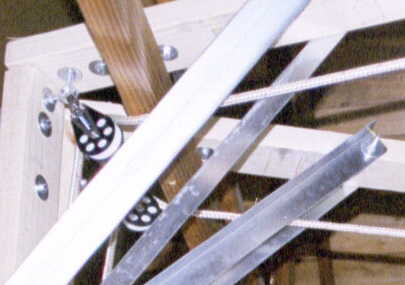

Most of the bolts you see attach the boards to a right-angle metal bracing holding the two boards together. The pulleys are each attached to two perpendicular eye hooks. The pulleys aren't low enough to clear the first beam, so the ropes rub against the beam.
If the pulley were attached to the horizontal board only, the horizontal board would be pulled one way by this pulley and equally in the opposite direction by a pulley at the suspension, and there would be no horizontal pull on the top of the vertical board. As long as the rope is making a 90 degree bend, the pulley will hang at a 45 degree angle. My favorite design would have been to hang the pulley from a loop of rope rather than eyehooks. The loop of rope would have been pulled against a nail or two on top of the horizontal board at its end.
The vertical bar is pulled forward slightly at the bottom by the tension on the rope. The 45-degree bracing on both sides of each beam is there to counter that. The weight of the vertical bar alone would have countered that, so the bracing isn't needed. The bracing traps a top beam, so this can't be dismantled without tools. Come to think of it, if we had put the top pulley further from the joint to increase its pull on the vertical section, we could have hinged the vertical section and made it automatically swing up out of everyone's way. Ah well, next time.
The parts were expensive (particularly the pulleys), we figure we spent $200 on it total. But, how often do you get to design something with pulleys? Bob and Bill had never had a chance to play with pulleys before, so we splurged. We went through a dozen of designs before reaching the one we actually built. It was a fun project.